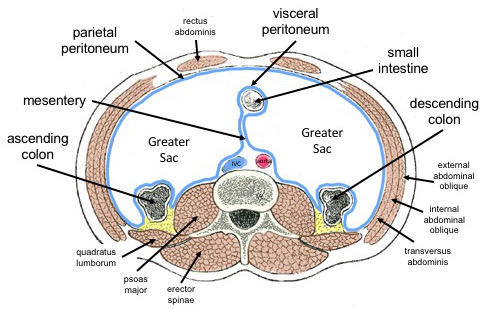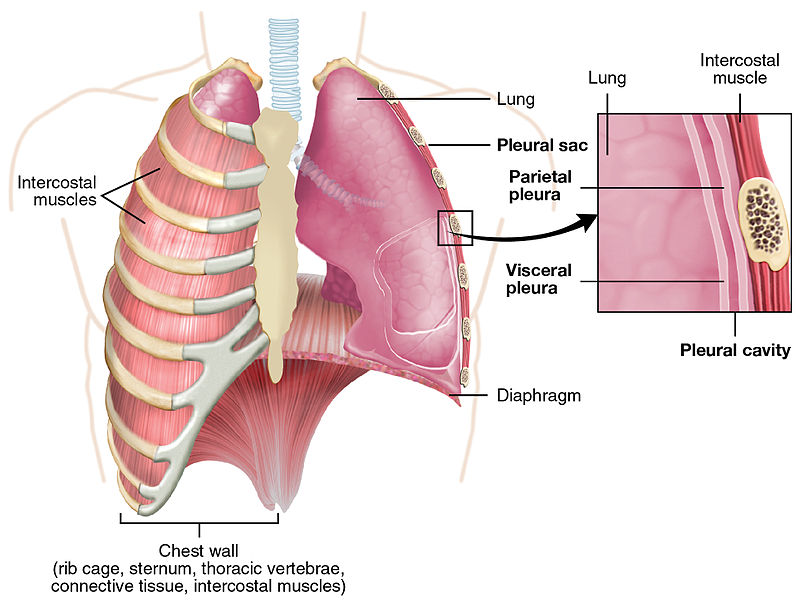Difference Between Visceral and Parietal Serous Membranes
Table of Contents
The key difference between visceral and parietal serous membranes is that visceral serous membranes cover the organs while parietal serous membranes line the walls of the body cavity.
The serous membrane is a single layer of flattened mesothelial cells. As a membrane, it fulfils two major functions. Firstly, it holds internal organs in place in the respective body cavity. Secondly, it allows organs to move freely relative to one another. The serous membrane forms two layers as the visceral membrane and parietal membrane. Visceral membrane covers organs in body cavities while parietal membrane lines the wall of the body cavity. In between two serous membranes, there is a very thin fluid-filled serous space. Serous membranes secrete this fluid to reduce the friction between them.
CONTENTS
1. Overview and Key Difference
2. What are Visceral Serous Membranes
3. What are Parietal Serous Membranes
4. Similarities Between Visceral and Parietal Serous Membranes
5. Side by Side Comparison – Visceral vs Parietal Serous Membranes in Tabular Form
6. Summary
What are Visceral Serous Membranes?
The visceral serous membrane is one of the two forms of serous membranes. The word ‘viscera’ means ‘organs’. Hence, the serous membrane that covers the internal organs is the visceral serous membrane. Visceral serous membrane originates from the splanchnic mesoderm.

Figure 01: Visceral and Parietal Pleura
There are three main types of visceral serous membranes: visceral pleura, visceral pericardium and visceral peritoneum. Visceral pleura covers the lungs. Visceral peritoneum wraps organs located inside the intra-peritoneal space while visceral pericardium covers the heart.
What are Parietal Serous Membranes?
Parietal serous membrane originates from the somatic mesoderm. It is the outer layer that lines the wall of body cavities. The word ‘parietes’ means ‘walls’. Hence, the serous membrane that lines the walls of three main body cavities is the parietal serous membrane. Accordingly, there are three parietal serous membranes as parietal pleura, parietal pericardium and parietal peritoneum.

Figure 02: Parietal and Visceral Peritoneum
Parietal pleura covers the mediastinum, pericardium, diaphragm and thoracic wall. Similarly, parietal pericardium lines the walls of pericardium while the parietal peritoneum lines the abdominal wall and pelvic walls.
What are the Similarities Between Visceral and Parietal Serous Membranes?
- Visceral and parietal serous membranes are two forms of serous membranes.
- There is a thin fluid-filled space between these two membranes.
- Both are able to secrete the fluid that fills between them.
- Moreover, these membranes are composed of a mesothelial cell layer.
- They are mesodermally-derived epithelia.
- Connective tissue supports both membranes.
- They form an airtight seal around the body cavity.
- Besides, they protect internal organs.
- Furthermore, they allow the frictionless movement of the heart and lungs and the organs of the abdominal cavity.
- They also regulate the movement of fluids and other substances across the membrane.
What is the Difference Between Visceral and Parietal Serous Membranes?
Visceral and parietal serous membranes are two forms of serous membranes. Visceral serous membrane is the inner layer that covers internal organs while the parietal serous membrane is the outer layer that lines the wall of body cavities. So, this is the key difference between visceral and parietal serous membranes.
Furthermore, the splanchnic mesoderm forms the visceral serous membrane while the somatic mesoderm forms the parietal serous membrane. Therefore, we can consider this too as a difference between visceral and parietal serous membranes. Moreover, visceral pleura, visceral peritoneum and visceral pericardium are three main types of visceral serous membranes while parietal pleura, parietal peritoneum and parietal pericardium are three types of parietal serous membranes.
Below infographic shows more comparisons related to the difference between visceral and parietal serous membranes.

Summary – Visceral vs Parietal Serous Membranes
The serous membrane is the membrane that lines body cavities such as peritoneal, pleural and pericardial cavities. There are two types of serous membranes: visceral serous membrane and parietal serous membrane. Moreover, the parietal serous membrane is the outer layer that lines the wall of the body cavity. On the other hand, the visceral serous membrane is the inner layer that covers internal organs. So, this is the key difference between visceral and parietal serous membranes.
Reference:
1. “Boundless Anatomy and Physiology.” Lumen, Available here.
2.“Serous Membrane.” Wikipedia, Wikimedia Foundation, 16 Apr. 2019, Available here.
Image Courtesy:
1. “2313 The Lung Pleurea” By Dennis M DePace, PhD – Own work (CC BY-SA 4.0) via Commons Wikimedia
2. “General Distribution of the Peritoneum” By OpenStax College – Anatomy & Physiology, Connexions Web site, Jun 19, 2013 (CC BY 3.0) via Commons Wikimedia
ncG1vNJzZmivp6x7pbXFn5yrnZ6YsqOx07CcnqZemLyue8OinZ%2Bdopq7pLGMm5ytr5Wau27CyKyanqqRoXqiusNmp5qqmZrBoriMrJyrp6Woeq6xzJupmqaVqHw%3D